Notifications
ALL BUSINESS
COMIDA
DIRECTORIES
ENTERTAINMENT
FINER THINGS
HEALTH
MARKETPLACE
MEMBER's ONLY
MONEY MATTER$
MOTIVATIONAL
NEWS & WEATHER
TECHNOLOGIA
TV NETWORKS
VIDEOS
VOTE USA 2026/2028
INVESTOR RELATIONS
COMING 2026 / 2027
ALL BUSINESS
COMIDA
DIRECTORIES
ENTERTAINMENT
FINER THINGS
HEALTH
MARKETPLACE
MEMBER's ONLY
MONEY MATTER$
MOTIVATIONAL
NEWS & WEATHER
TECHNOLOGIA
TV NETWORKS
VIDEOS
VOTE USA 2026/2028
INVESTOR RELATIONS
COMING 2026 / 2027
About Me
 Latinos Media
Latinos Media Latinos Media provides all types of news feeds on a daily basis to our Members
Posted by - Latinos Media -
on - April 19, 2023 -
Filed in - Marketing -
-
649 Views - 0 Comments - 0 Likes - 0 Reviews

Over the last several years, I’ve written frequently about the lack of CMO engagement in technology strategy and management. This is changing, albeit slowly. I’m now starting to see CMOs actively participating in strategy discussions, working hand in hand with their tech lead to make decisions about what to acquire and what to retire.
That said, I’m surprised how many CMOs still keep their distance from the tech part of their function. The days of a CMO delegating the martech strategy to their MOps team are at an end. The emergence of generative AI, particularly ChatGPT, has changed everything.
This article explores why today’s CMOs should prioritize marketing technology strategy and create internal policies for using generative AI.
 Image created by Dall-E
Image created by Dall-E
The case for CMO engagement in technology was already compelling:
Dig deeprer: Why CMOs must be the company’s biggest advocates for digitalization
The impact of ChatGPT on marketingThere is no longer a clear demarcation line between technology and content. It’s now feasible to leverage AI to create text, video and animations. More importantly, ChatGPT’s simple user interface has the potential to completely transform how companies engage with their customers and deliver information.
For me, the simple video that HubSpot produced to introduce Chatspot.ai drove this home. In 19 minutes, Dharmesh Shah, Founder and CTO at HubSpot, demonstrates the power and potential of AI visually and understandably. Every marketer should watch this video and think about how this type of interface and technology might augment and improve the customer journey and experience.
As vendors introduce new AI-enabled capabilities, it will require reevaluating the components of the martech stack and potentially replacing anchor systems that have been in place for a long time. It’s worth noting that historically, in times of great innovation, new technology leaders emerge and that’s likely to be the case with AI.
What today might look like mature and stable technology categories (e.g., CRM, marketing automation) may look entirely different within the next five years. Today’s market leaders may not be the leaders of tomorrow. It’s often much easier to start building from the ground up than deal with the technology legacy (a.k.a., technology tax) of an existing platform when trying to provide a leap in innovation. It’s important not to be complacent and to stay on top of shifts and changes.
Complicating the evolution of the martech stack is the normal cycle of marketing hype associated with “shiny new things.” Companies are adding AI to their product descriptions without actually delivering anything that leverages AI.
The challenge is to separate legitimate from non-legitimate claims. A straightforward way to test is to look at the size of the data set a vendor is using to deliver their capabilities. Regardless of product category, if a vendor is not working with a large dataset, they aren’t leveraging AI. To be effective, AI needs a large training set of data in order to learn.
In addition, if a product leverages AI, it doesn’t always mean it is a better choice than an equivalent product that doesn’t leverage AI. It’s important to understand what differentiation their use of AI actually delivers.
A further complication is that a lot of venture capital is going into technology companies focused on leveraging AI to deliver a broad range of new capabilities. There is already an extensive category of generative AI products and an equally robust category of AI detection tools.
Not all of these companies will make it. At some point, the market will become saturated with investment, the venture capitalists will move on and some companies will implode.
Dig deeper: AI in marketing: 7 areas where it shines and struggles
The CMO and ChatGPTThe CMO’s job is to understand where AI, particularly generative AI, fits within the marketing strategy.
Making that decision requires an understanding of the capabilities and limitations of the technology, the products that deliver those capabilities and the associated ethical and compliance issues that surround AI.
Italy, for example, has banned ChatGPT (at least temporarily) over concerns that the training data OpenAI used contravened GDPR. Copyrighting AI-generated content is a grey area at the moment. The U.S. Copyright Office has said it will consider copyrights on a case-by-case basis. This is something that is going to evolve over time.
CMOs should consider internal policies around the use of generative AI. I’m more than happy for my team to leverage generative AI for inspiration around email flows and to create multiple versions of content for A/B testing. At the same time, I want to ensure that we proceed cautiously with AI-generated articles, blog posts and other content that may get flagged and penalized by the search engines for being AI-generated.
While it’s not clear how well search engines can detect AI content today, it’s definitely an area of focus for them, particularly given the concerns related to spreading disinformation and deep fake imagery.
As generative AI gets more sophisticated, so will the technology for detecting it. There’s no point in investing in AI-generated content if it will be buried by a search engine.
Dig deeper: How CMOs should respond to ChatGPT’s marketing impact
This is not the time to question the value of your content marketing teamOne thing that ChatGPT will not eliminate is the need for human content creators — at least not yet. ChatGPT and other generative AI tools can be great content assistants and, at some level, content creators. But they are not a replacement for your content team.
These tools look back at the data they have. Without data about your new product, they can’t effectively write about it or deliver the nuances of your value proposition and positioning. Marketing strategy, creative direction and decisions need a human touch and will for the foreseeable future.
The need to articulate an AI strategyAt some point, in an executive or board meeting, CMOs will be asked to articulate how AI fits into the marketing strategy. While the CMO should be able to call on their technology head to talk about technical details, products and implementation, they should be the ones to talk about the overall strategy.
To be clear, AI and ChatGPT are not synonymous. ChatGPT is a natural language processing tool driven by AI technology that allows you to have human-like conversations and much more with the chatbot.It exists under the category of generative AI. AI technology as an enabler exists in many different algorithms. You can have a ChatGPT strategy, and that may be your starting point for embracing AI, but it shouldn’t be characterized as your overall AI strategy.
AI has tremendous potential across many marketing categories. For example, it can be leveraged to define micro-market segments, adapt the customer journey and deliver a high degree of personalization. Many of the tools in your stack today may already be leveraging AI.

Today’s CMOs should prioritize marketing technology strategy and work hand in hand with their technology lead. Advances in AI will serve as a forcing function in this regard.
If the CMO does not own the AI and technology strategy, they cannot effectively create an overall marketing strategy. It is imperative that a CMO be able to articulate how they will achieve their marketing strategy, and technology is very much a critical piece of that.
CMOs do not have to be deeply technical. They do, however, need to understand the following:
At the end of the day, it is the CMO who is measured on marketing’s success. If success is impeded by poor technology choices, the CMO is and should be accountable.
For those CMOs who have not yet crossed the divide and immersed themselves in marketing technology, I recommend the following:
The post Why CMOs must cross the technical divide appeared first on MarTech.